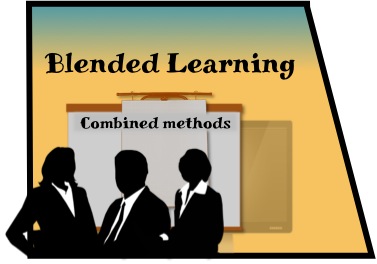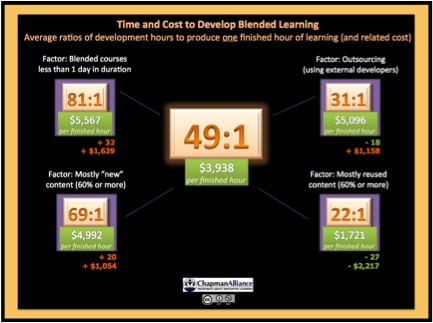What Are the Goals and Costs of
Designing Blended eLearning?
by Adele Sommers
 What’s so special about blended learning solutions, and why do they matter? Why not aim for homogeneity — so that every aspect of a training curriculum reflects the same media, methods, and modes? What’s so special about blended learning solutions, and why do they matter? Why not aim for homogeneity — so that every aspect of a training curriculum reflects the same media, methods, and modes?
One key consideration is the learners’ circumstances of use. Does one single training approach best serve all of the needs and conditions under which the audience members will be learning?
Example 1: Consider typical corporate employees who juggle many high-priority challenges in fast-paced environments. Attending classroom sessions for hours on end may be problematic. But if some of that training content could be relegated to self-paced eLearning, it could allow learners to consume it in smaller chunks at their own pace. Thus, offering a blended curriculum could help learners fit the entirety of the training program into their schedules more easily.
Example 2: Imagine another situation in which employees need to be in the field or roam their facilities all day. Even if self-paced eLearning were available, finding quiet times to concentrate in front of an office computer may be an infrequent luxury. But if that content were designed to be mobile-device-compatible, these folks could pull up the courseware on a tablet whenever they have a few free minutes on the go. Or, they might prefer carrying around PDF printouts on a clipboard, especially if they’re in and out of wi-fi range and the electronic content isn’t available offline. The bottom line is that blending two or more alternatives would support the employees’ logistical needs and working conditions better than any single approach.
Many situations call for more flexible, as well as non-traditional, learning design. Read on to explore blended learning in more detail, including how long it takes, and how much it costs, on average, to produce it.
What Are Some Advantages of Blended Learning?
For all of the reasons described above, two of the greatest advantages of blended learning include effectiveness and efficiency. These aspects can work together in complementary ways, as explained next.
Effectiveness: Some instructional content lends itself to one medium, method, or mode, but not to another. For example:
 For demonstrations of proficiency that require an instructor to observe someone’s ability to perform a task, an in-person rather than an online approach is often required, unless that task can be viewed remotely using a Web cam, for example. For demonstrations of proficiency that require an instructor to observe someone’s ability to perform a task, an in-person rather than an online approach is often required, unless that task can be viewed remotely using a Web cam, for example.
- Certain types of group-based and problem-solving activities occur more easily and naturally in face-to-face settings. (It might be possible to host the same group experience online with the proper tools and technology, but it also could be a bit more cumbersome.)
- On the flip side, realistic electronic simulations are sometimes the only way to safely and effectively learn certain skills that would otherwise be too expensive or dangerous to perform under real-world conditions until the learners attain a specific level of proficiency. Pilot training is one example.
Efficiency: In many situations, it’s more economical and productive to provide at least some aspects of a curriculum in a self-study mode. Consider that learners often can master terminology, concepts, and principles more efficiently using self-paced eLearning than in a classroom setting. Construction management, driver training, and culinary arts, for example, all eventually require plenty of hands-on, real-world training and practice. But learning the applicable safety rules in each case might occur more flexibly and less expensively through eLearning — making a strong case for blending!
Which learning “ingredients” should we blend?
An optimal learning model should consider all of the following to determine which combinations would best support the content, circumstances, and audience’s needs:
 Modes (such as self-paced vs. instructor-led approaches) Modes (such as self-paced vs. instructor-led approaches)
- Methods of presenting and sharing content (such as lecture, scenario-based discovery, team collaboration, simulations, discussion forums, hands-on experimentation, games)
- Media for embodying the content (ideally striving to support a high degree of learner engagement and varied learning modalities, such as by combining text, images, video, audio, animations, interactive elements)
- Delivery vehicles (such as a classroom, computers, mobile devices, documents)
- Resources and memory support (such as online tools, downloadable files, and laminated job aids)
The many creative examples of blended learning “recipes” reflect the plethora of ingredients from which to choose. Therefore, any single blended learning solution could embody several of these elements:
- Web seminars
- Self-paced eLearning
- Face-to-face instructor-led training
- Live and recorded Web seminars (webinars)
- Content delivered on mobile devices
- Virtual classroom training
- On-the-job training (OJT)
- Social collaboration
- Informal learning
- Hands-on labs
- Mentoring
- Coaching
What learning content and materials can we produce?
Blended learning can involve of a wide range of instructional output, such as:
- Presentation slide decks
- eLearning modules
- Participant guides, instructor guides
- Knowledge assessments, quizzes, tests
- Job aids, reference manuals, textbooks
- Videos, webinar recordings, podcasts
- Handouts, workbooks
- Course evaluations
- Posters
- Blogs
- Wikis

What implementation strategies can we use?
As we have seen, the strategies we select to implement a blended model should depend on the situation, the subject matter, the needs and characteristics of the target audience — and also the available time, resources, and budget.
For example, with a smaller budget or a shorter schedule, it may be desirable to:
- Repurpose some existing content rather than creating it all new. That decision could result in a mix of elements that represent a kind of blending. If, on the other hand, we have plenty of time and budget, we might opt to develop all-new content and also consider what is most desirable, instead of most expedient, to blend.
- Use blended learning as an interim step toward converting all of our course content from instructor-led training into self-paced eLearning, for example. If our long-term objective is to move all of our classroom-based courses online, we could start by creating some initial eLearning modules, while leaving the rest of the content classroom-based in the meantime.
How Long Does Blended Learning Take to Create?
In 2013, the Chapman Alliance published a comprehensive research study* on how long it takes to design and develop one hour of blended learning. Since no “standard type” of blended learning exists (as the combination of content, media, methods, and so on, can differ in each case), the average development times and costs are based on specific factors rather than on levels of quality or complexity, as shown below:
 (Click the image to enlarge) (Click the image to enlarge)
Note that these are just a few of the many factors that can influence the time and cost to develop blended learning.
Overall average of all factors combined:
The overall development time for blended learning is an average of 49 hours of effort to produce one finished hour of learning, taking all factors into account. The average price per finished hour of blended learning is $3,938.
Factor: Outsourcing (using external developers):
Outsourcing a blended project reduces the time-to-develop ratio to an average of 31 hours for each finished hour. However, typical vendor markups increase the average cost to $5,096 per finished hour ($1,158 more than the overall average).
Factor: Mostly reused content:
Repurposing existing training content (so it comprises 60% or more of the blended course) reduces the average time-to-develop ratio to an average of 22 hours for each finished hour. The average cost per finished hour is $1,721 ($2,217 less than the overall average).
Factor: Mostly “new” content:
Creating mostly new training content (so it comprises 60% or more of the blended course) increases the average time-to-develop ratio to an average of 69 hours for each finished hour. The average cost per finished hour is $4,992 ($1,054 more than the overall average).
Factor: Blended courses less than 1 day in duration:
Producing blended courses that are less than one day long increases the time to develop one hour of finished learning to an average of 81 hours. The average cost per finished hour is $5,567 ($1,629 more than the overall average), which makes this factor one of the costliest. These data suggest that paring a course down to fit into a highly compressed delivery window requires considerable effort, especially when multiple learning modalities are involved.
_________________
*Data source:
Chapman, B. (2013). Large Scale, Blended Learning Development: Benchmark [Research Study]. Published by Chapman Alliance LLC, available from chapmanalliance.com. The image was used and adapted with permission. The average times and costs are based on data from 188 organizations. Note that there was no “standard type” of blended learning, as each group used a different combination of content, media, and delivery methods.
In conclusion, which eLearning model should we choose? The selection we make should depend on the subject matter, the needs and characteristics of the target audience, and available time, resources, and budget. Because time and cost tradeoffs sometimes require us to simplify our approach to manage with a smaller budget or shorter schedule, the more complex implementations may not be feasible even if they are warranted. However, with creative planning, it may be possible to begin with a simple approach and phase in more functionality over time!
That wraps up this series — thank you so much for participating in the journey! For additional ideas, you might want to refer back to:
Copyright 2023 Adele Sommers
|


